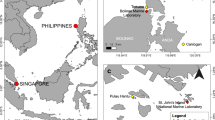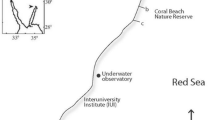Abstract.
The reproductive biology of the solitary ahermatypic coral Monomyces rubrum was studied in northeastern New Zealand between January 1996 and January 1998. The period of oogenesis lasted around 11 months, from late January to December, while spermatogenesis was more rapid, starting in late August and culminating in a spawning period in early December. Reproduction commenced at a polyp size of around 1,000 mm3 (5–6 years old) and the maximum estimated fecundity of the largest corals (7,000 mm3) was no more than 200 eggs. Oocytes were probably fertilized while within the mesentery and were shed into the coelenteron where they developed, via a solid blastula stage, for approximately 1 month. Planulae were relatively large, 3–4 mm in length and 1–2 mm diameter at the time of release, and crawled or swam immediately to the substratum. Peaks of planula shedding were semi-lunar in January 1997, but only one peak was observed in January 1998. The production of a few large rapidly settling larvae by this member of the family Flabellidae is consistent with the trend for solitary short-lived corals from other families to brood larvae rather than spawn gametes.
Similar content being viewed by others
Author information
Authors and Affiliations
Additional information
Electronic Publication
Rights and permissions
About this article
Cite this article
Heltzel, .P., Babcock, .R. Sexual reproduction, larval development and benthic planulae of the solitary coral Monomyces rubrum (Scleractinia: Anthozoa). Marine Biology 140, 659–667 (2002). https://doi.org/10.1007/s00227-001-0745-x
Received:
Accepted:
Issue Date:
DOI: https://doi.org/10.1007/s00227-001-0745-x




